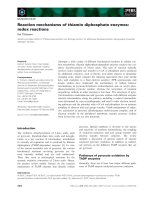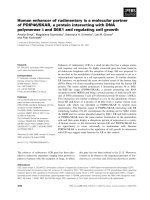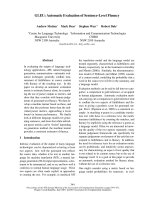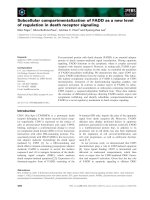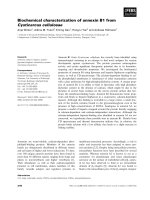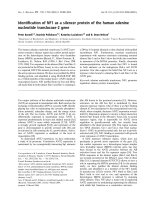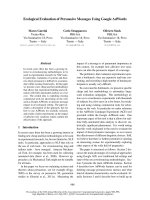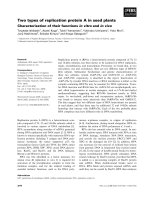Báo cáo khoa học: "Clinical experience of novel interconnected porous hydroxyapatite ceramics for the revision of tumor prosthesis: a case report" pdf
Bạn đang xem bản rút gọn của tài liệu. Xem và tải ngay bản đầy đủ của tài liệu tại đây (489.2 KB, 5 trang )
BioMed Central
Page 1 of 5
(page number not for citation purposes)
World Journal of Surgical Oncology
Open Access
Case report
Clinical experience of novel interconnected porous hydroxyapatite
ceramics for the revision of tumor prosthesis: a case report
Yukihiro Yoshida*
1
, Shunzo Osaka
2
and Yasuaki Tokuhashi
1
Address:
1
Department of Orthopedic Surgery, Nihon University School of Medicine, Tokyo, Japan and
2
Nerima Hikarigaoka Hospital, Nihon
Univeristy 2-11-1, Hikarigaoka Nerima-ku, Tokyo, Japan
Email: Yukihiro Yoshida* - ; Shunzo Osaka - ; Yasuaki Tokuhashi -
u.ac.jp
* Corresponding author
Abstract
Background: As for being cautious with tumor prostheses, revision of uncemented tumor
prostheses in particular, it is necessary to remove cortical bone from the stem circumference with
a chisel when the stem is extracted. This assures that bone in-growth will occur within the stem in
itself. As a result, re-substitution of mass autogenous bone graft round a new stem is subsequently
necessary. When rivision of uncemented tumor prosthesis of distal femur was performed, we
evade fibula transplant by transplanting interconnected porous hydroxyapatite ceramic (IP-CA:
Neobone) with a self bone, and reports its experience with the case that acquired enough strength.
Case report: In this report, we present the case of a 27-year-old female with stem breakage of
tumor prosthesis and do revision surgery for prosthetic failure. In the case of revision surgery,
autologous bone and Neobone were mixed, and this was transplanted to stem circumference. The
Radiological Evaluation System of the ISOLS showed excellent results for all items. She can walk
without using a cane or orthosis, and the score of the MSTS is 80%.
Conclusion: When revision of uncemented tumor prostheses of the distal femur was performed,
we avoided fibula graft by using Neobone with the patient's own bone tissue. Our experience with
this case may indicate that adequate strength is achieved.
Background
In surgery for malignant bone tumors, the implantation
of joint prostheses for tumors (tumor prostheses) after
wide resection is an important reconstruction method.
However, complications such as infection and prosthesis
fracture develop in some cases [1,2]. To enhance bone
strength around the stem of a femoral component, we
used an interconnected porous hydroxyapatite ceramic
(IP-CA: Neobone) in combination with an autogenous
bone graft.
Case report
A 27-year-old female was referred to our hospital on May
16, 1996 and admitted due to a suspected malignant bone
tumor in the left distal femur. On May 20, biopsy was per-
formed. Histopathological examination demonstrated
osteosarcoma, and preoperative chemotherapy was
immediately performed according the chemotherapy pro-
tocol of our department for osteosarcoma. On September
25, wide resection was performed, and the affected limb
was reconstructed using a tumor prosthesis (Howmedica
Published: 21 October 2009
World Journal of Surgical Oncology 2009, 7:76 doi:10.1186/1477-7819-7-76
Received: 29 July 2009
Accepted: 21 October 2009
This article is available from: />© 2009 Yoshida et al; licensee BioMed Central Ltd.
This is an Open Access article distributed under the terms of the Creative Commons Attribution License ( />),
which permits unrestricted use, distribution, and reproduction in any medium, provided the original work is properly cited.
World Journal of Surgical Oncology 2009, 7:76 />Page 2 of 5
(page number not for citation purposes)
Modular Reconstruction System: HMRS). Subsequently,
postoperative chemotherapy was performed for about 6
months. On May 2007, about 11 years after the operation,
she noticed pain in the left thigh during walking. Due to
gradual aggravation of the pain, she visited our depart-
ment on September 6, 2007. X-ray examination revealed
fracture at the base of the stem of the femoral component
(Fig. 1). We planned revision using a tumor prosthesis,
and obtained a custom-made femoral component stem
(diameter, 12 mm; length, 15 cm). Until the completion
of the stem, a knee-ankle-foot orthosis was employed, and
crutches were used for walking. The preoperative score of
the Musculoskeletal Tumor Society was 60%. On Novem-
ber 7, 2007, revision surgery was performed. The wound
was exposed using the previous skin incision. Bone forma-
tion at the stem base was good. Rectangular fenestration
along the stem in the bone was performed in the proximal
femur using a chisel, and the stem in the bone was
removed. A new stem was inserted, and adequate grafting
with Neobone and autogenous bone was performed
around the stem. Only the bearing bush and femoral com-
ponent were replaced with new ones, and the operation
was completed (Fig. 2). Two weeks after the operation,
passive range-of-motion training was initiated. Until 6
weeks after surgery, no weight bearing was performed.
Seven weeks after the operation, walking training was ini-
tiated using a knee orthosis with gradual weight bearing.
The knee orthosis was used until 6 months after the oper-
ation. At present, about one year after surgery, good bone
formation around the stem is observed on plain X-ray
films. Evaluation using The Implant Evaluation System of
the International Symposium on Limb Salvage showed
Plain X-ray films at the time of stem fractureFigure 1
Plain X-ray films at the time of stem fracture.
World Journal of Surgical Oncology 2009, 7:76 />Page 3 of 5
(page number not for citation purposes)
excellent results for all items (Bone remodeling, Interface,
Anchorage) after as well as before the operation (Fig. 3).
She can walk without using a cane or orthosis, and the
score of the Musculoskeletal Tumor Society is 80%.
Discussion
Due to recent advances in surgery and chemotherapy for
primary malignant bone tumors, the survival rate has
increased, and the usefulness of tumor prostheses as a
limb reconstruction method has also been confirmed.
However, complications such as infection associated with
these prostheses and their loosening and fracture have
presented problems. Concerning stem fracture, in 1994, R
Capanna et al. reported stem fracture of modular unce-
mented tumor prostheses in 6 (6.3%) of 95 patients[2]. In
2001, Mittenmayer et al. reported major complications in
19 of 100 patients using uncemented tumor prostheses,
consisting of 11 patients showing aseptic loosening and 4
each showing septic loosening and implant fracture [3]. In
addition, in 2006, G Gosheger et al. reported stem fracture
in 4 (1.6%) of 250 patients using uncemented tumor
prostheses[4]. At our department, stem fracture has been
observed in 5 patients, and the mean duration until the
fracture was 4 years and 6 months (10 months-9 years).
The system used was the KMFTR implant (Kotz Modular
Femur and Tibia Reconstruction System) in 4 patients and
the PH type 1 (Physio hinge type 1) in the remaining one.
The stem diameter was 10 mm in 4 patients and 11 mm
in 1. Both stems were relatively thin for the distal femur.
After revision, the stem diameter was 10 mm in only 1
patient, and stems with a greater diameter than those in
the previous operation were used in the others. The possi-
ble causes of stem fracture include improvement in
patients' activity and stem loosening. In general, stem
fracture is considered to be associated with the design
(hinge-type structure) of prostheses themselves[5]. Some
authors have recommended the use of relatively thick
rather than thin stems[3,6]. Various tumor prostheses
have been studied and developed by researchers, but opti-
mal prostheses have not yet been produced[7].
Unlike conventional hydroxyapatite (HA) ceramics, IP-
CA was developed employing a new concept with impor-
tance placed on interconnectivity among air pores. IP-CA
also allows new bone to enter air pores in the deep area,
and has adequate strength for clinical use[8]. Myoui et al.
used IP-CA in 62 surgically treated patients with benign
bone tumor, bone fracture, and inflammatory diseases,
Insertion of a new stem and adequate reinforcement with artificial and autogenous boneFigure 2
Insertion of a new stem and adequate reinforcement with artificial and autogenous bone.
World Journal of Surgical Oncology 2009, 7:76 />Page 4 of 5
(page number not for citation purposes)
and observed favorable clinical results[9]. On X-ray films,
the border between IP-CA granules and between IP-CA
and bone became unclear due to marked osteosclerosis in
61% of the patients after 6 months. Concerning caution-
ary items at the time of filling during the operation,
Nakase et al. described that the initial strength acquired is
lower using IP-CA than cortical bone, and recommended
that the initial strength should be made as high as possi-
ble by combining IP-CA with autogenous cortical bone in
fragile areas such as the bone fracture area[10]. In our
patients, for the reinforcement of the femoral stem, IC-PA
was mixed with autogenous cortical bone to achieve max-
imal initial strength. On X-ray films, the borders between
IP-CA and autogenous bone became unclear. X-ray rating
by Myoui et al. was Grade 3.
Conclusion
At the time of the revision of the tumor prosthesis, to
enhance the strength of bone around the stem, we
planned to use a large amount of autogenous bone. How-
ever, fibula grafting could be avoided by the grafting of
both Neobone and autogenous bone. Although further
careful observation of the course is necessary, favorable
bone formation was observed. This grafting of both
Neobone and autogenous bone may also be useful for
preventing stress shielding in joint replacement with
tumor prostheses.
Consent
Written informed consent was obtained from a relative of
the patient for publication of this case report and any
accompanying images. A copy of the written consent is
available for review by the Editor-in-Chief of this journal.
Competing interests
The authors declare that they have no competing interests.
Authors' contributions
YY wrote the manuscript, SO contributed to the manu-
script, YT critically reviewed the manuscript. All authors
read and approved the manuscript.
References
1. Scales JT, Sneath RS: Bone Tumor Management. The extending
prosthesis. Butterworth 1987:168-177.
2. Lewis MM: Use of expandable and adjustable prosthesis in the
treatment of childhood malignant bone tumors of the
extremity. Cancer 1986, 57:499-502.
Postoperative bone formation around the stemFigure 3
Postoperative bone formation around the stem. Granular forms were still observed 1 month after the operation, but
the borders between IP-CA granules and between IP-CA and bone became unclear, and sclerotic changes were observed
around the stem, suggesting adequate bone strength.
Publish with BioMed Central and every
scientist can read your work free of charge
"BioMed Central will be the most significant development for
disseminating the results of biomedical research in our lifetime."
Sir Paul Nurse, Cancer Research UK
Your research papers will be:
available free of charge to the entire biomedical community
peer reviewed and published immediately upon acceptance
cited in PubMed and archived on PubMed Central
yours — you keep the copyright
Submit your manuscript here:
/>BioMedcentral
World Journal of Surgical Oncology 2009, 7:76 />Page 5 of 5
(page number not for citation purposes)
3. Kotz R, Schiller C, Windhager R, Ritschl P: Limb salvage: major
reconstruction in oncologic and nontumoral conditions. In
Endoprostheses in children: first results Edited by: langlais F, Tomeno B.
Berlin: Spring Verlag; 1991:591-599.
4. Schindler OS, Cannon SR, Briggs TW, Blunn GW: Stanmore cus-
tom-made extendabible distal femur replacements. Clinical
experience in children with primary malignant bone tumors.
J Bone Joint Durg [Br] 1997, 79:927-937.
5. Schiller C, Windhager R, Fellinger EJ, Salzer-Kuntschik M, Kaider A,
Kotz R: Extendable tumor endoprostheses for the leg in chil-
dren. J Bone Joint Surg [Br] 1995, 77:608-614.
6. Dominkus M, Krepler P, Schwameis E, Windhager R, Kotz R:
Growth prediction in extendable tumor prostheses in chil-
dren. Clin Orthop 2001, 390:212-220.
7. Kotz R, Salzer M: Rotation-plasty for childhood osteosarcoma
of the distal part of the femur. J Bone Joint Surg [Am] 1982,
64:959-969.
8. Myoui A, Yoshino M, Araki N, et al.: A Clinical experience with
novel interconnected porous hydrokyapatite ceramics for
the treatment of bone defects. Rinshou Seikeigeka 2001,
36(12):1381-1388. In Japanese
9. Myoui A, Yoshikawa H: Interconnected porous hydroxyapatite
ceramics development, clinical applications and future pros-
pects. J Musculoskeleta system 2004, 17(11):1205-1215. In japanease
10. Nkase T, Hujii S, Hayaishi T, et al.: Use of a novel Hydroxyapatite
ceramics for treatment of osseous defect after fractures.
Orthopedic Surgery 2006, 47:192-196. In Japanese

